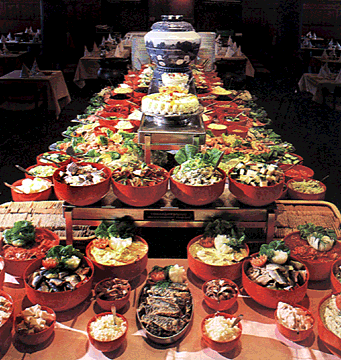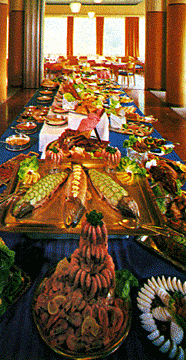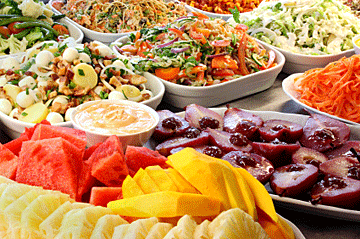The
Smorgasbord:
A Mirror of Scandinavian Cuisine
by Bob Brooke
 A
major feature of Scandinavian eating is the “cold table”— A
major feature of Scandinavian eating is the “cold table”—
Danish koldt
bord,
Finnish voileipapoyta,
Norwegian koldtbord,
Swedish smorgasbord—literally a table bearing many different
cold items from which guests can choose, returning as often as they
like. It’s a reflection of the variety of Scandinavian cuisine.
The dishes reflect the rich harvests
yielded by sea, river and lake, the game and fruits of the forests and
mountains, as well as the more usual products of farm and market garden.
Though the breakfast version is relatively modest–it usually includes
the much-loved salted herring, ham and possibly other cold meats,
cheeses, tomatoes, eggs, cereals and different breads–the dinner
version can be a veritable feast for the eye and the palette.
To accompany the food is
a seemingly inexhaustible supply of coffee, milk and various skimmed or
sour milks, yogurt, and tea.
 It’s quite sensible for
diners to fill up at breakfast and dispense with a big lunch. The cold
table at main meals is a majestic sight, groaning under the weight of
dishes. Though there are variations from country to country, and from
region to region, diners are likely to come across most of the following
items at some time or other: lobster, smoked or dill-cured salmon,
smoked trout, prawns, shrimps, pickled or cured herring marinated or in
a variety of sauces, fried Baltic herring, smoked eel, thinly sliced
roast beef, veal, pork, smoked reindeer meat, reindeer tongue, ham,
liver pastes, tomatoes, onion rings, egg, pickled cucumber, gherkins,
beet root, and many preserves such as cranberry or red whortleberry.
Cheeses include imitations of popular foreign kinds such as Stilton,
Gruyere, Camembert, but there are also local varieties- Danish blue,
sweet soft goat's cheese and even, if you are bold, the exceedingly
strong gamalost, a delicious Norwegian “old cheese.” It’s quite sensible for
diners to fill up at breakfast and dispense with a big lunch. The cold
table at main meals is a majestic sight, groaning under the weight of
dishes. Though there are variations from country to country, and from
region to region, diners are likely to come across most of the following
items at some time or other: lobster, smoked or dill-cured salmon,
smoked trout, prawns, shrimps, pickled or cured herring marinated or in
a variety of sauces, fried Baltic herring, smoked eel, thinly sliced
roast beef, veal, pork, smoked reindeer meat, reindeer tongue, ham,
liver pastes, tomatoes, onion rings, egg, pickled cucumber, gherkins,
beet root, and many preserves such as cranberry or red whortleberry.
Cheeses include imitations of popular foreign kinds such as Stilton,
Gruyere, Camembert, but there are also local varieties- Danish blue,
sweet soft goat's cheese and even, if you are bold, the exceedingly
strong gamalost, a delicious Norwegian “old cheese.”
Food shops stock all of
these items for those who wish to create their own smorgasbord . When it
comes to desserts, the emphasis is on creamy soufles, tiered cakes, and
a variety of soft fruits and berries, among which the greatest delicacy
is the cloudberry from the northern marshlands.
A gastronomic highlight
of the Finnish and Swedish summer is the crayfish, a delicacy harvested
from shallow streams and eaten in their thousands during a fixed period
in July and August. Restaurants advertise special crayfish evenings and
supply diners with decorative bibs as it's quite a messy business for
the uninitiated. The crayfish are accompanied by aquavit, beer or white
wine, so it is usually a convivial occasion too. In Denmark, Limfjord
oysters are highly prized.
Many of the cold table
ingredients can easily be translated into delicious hot dishes. Salmon
comes in many forms. Fillet of reindeer or young elk or ptarmigan in a
cream sauce can be extremely good. Scandinavians love cream sauces,
often incorporating the delicately flavored mushrooms of which
Scandinavia has many varieties.
 Among less expensive
dishes are spiced meatballs, pea soup with pork–traditionally followed
by pancakes–and a whole range of fish such as cod, haddock, coalfish
and mackerel. Norwegian lutefisk or cod steeped in a lye of
potash–is definitely an acquired taste, as is Finland's kalakukko
or fish and pork baked in a kind of pie. Icelandic specialties include hargikjot
or smoked lamb, hardfiskur or dried fish and skyr or
splendid curds. Potatoes, usually boiled, are sometimes served with
dill. Fresh vegetables aren’t so common, but a flourish of lettuce,
tomato, beetroot, gherkin may well accompany a hot dish. Among less expensive
dishes are spiced meatballs, pea soup with pork–traditionally followed
by pancakes–and a whole range of fish such as cod, haddock, coalfish
and mackerel. Norwegian lutefisk or cod steeped in a lye of
potash–is definitely an acquired taste, as is Finland's kalakukko
or fish and pork baked in a kind of pie. Icelandic specialties include hargikjot
or smoked lamb, hardfiskur or dried fish and skyr or
splendid curds. Potatoes, usually boiled, are sometimes served with
dill. Fresh vegetables aren’t so common, but a flourish of lettuce,
tomato, beetroot, gherkin may well accompany a hot dish.
Scandinavians love their
coffee, served strong, either black or with cream, but they also like
cold milk. Excellent lager beer is widely available, with those from
Denmark the best. Icelandic beer, however, is almost non-alcoholic.
Local spirits are aquavit or schnaps and vodka of various kinds
served iced cold. Scandinavians also distill some interesting liqueurs
from northern berries, including those from Arctic bramble, cloudberry
and cranberry bushes.
In Denmark, restaurants
and bars serve alcohol of all kinds at any time during opening hours,
which are liberal. Finnish eateries serve only beer before Noon but
serve all other types until closing. Only very mild beer is available in
Iceland--alcohol is available from Noon to 2:30 P.M. and from 7:00 P.M.
to closing, but no spirits at all are served on Wednesdays. In Norway,
beer or wine is available at any time, while hard liquors are only
available after 3:00 P.M.
< Back to A
Taste of Scandinavia
Go to Traditional Norwegian
Cuisine > |